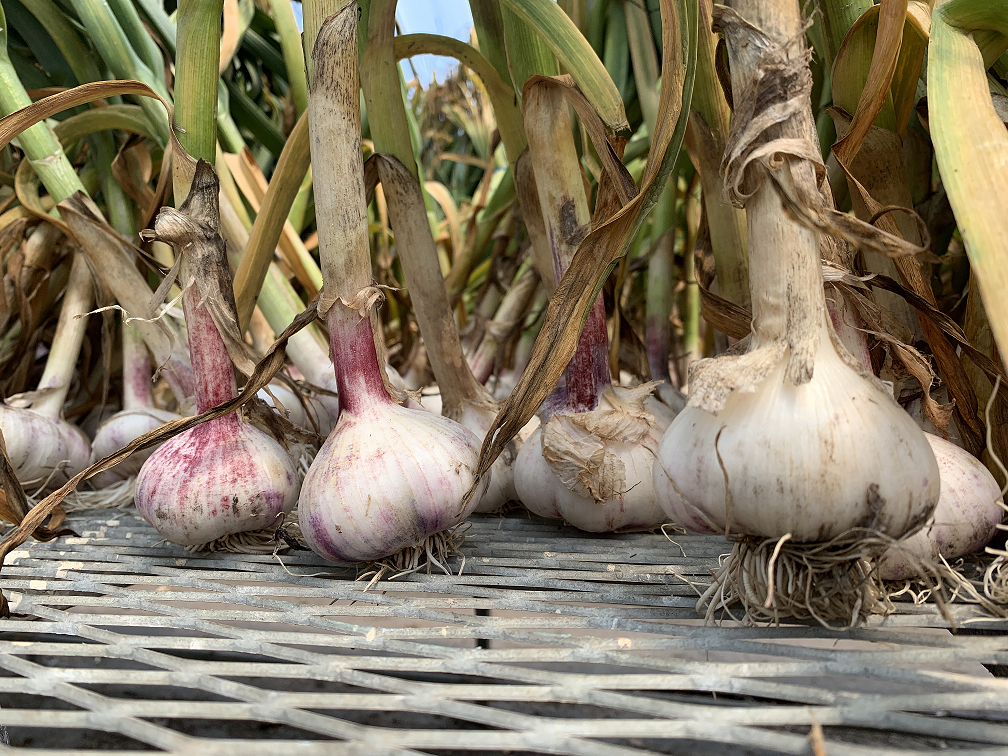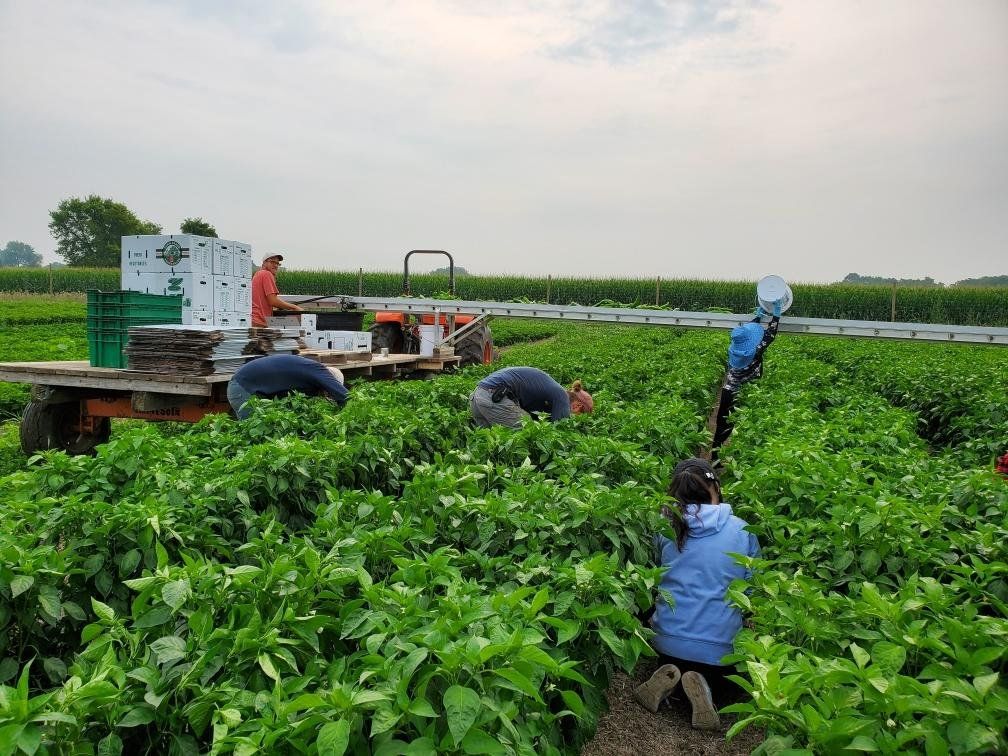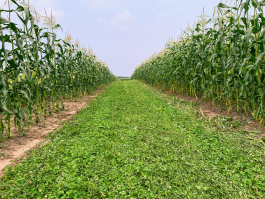Greetings,
Although the summery weather has been here since, well, spring, we are really feeling the shift in our harvests. This week brought the first sweet corn harvest and a bumper crop of green beans; next week we'll start picking peppers. And since peppers are the main crop we grow outside of those we need for CSA, the start of pepper harvest season is a big one for us. The photo below shows 1/3 acre of Anaheim chiles flanked by 3/4 acre of habaneros and 3/4 acre of assorted other hot peppers.

The garlic has been drying nicely in this warm, sunny weather. We have them in the greenhouse with shade cloth covering it, as the bulbs can be damaged by too much direct sun. They are about halfway cured - they seem dry on the outside, but the interior layers haven't fully dried into the papery "peels" you typically encounter when peeling garlic. They should be available for shares next week. Onions will come in in about two weeks.

A few notes on sweet corn, which is a crop we stopped growing a couple years ago because of a multitude of pest challenges: a fly larva that eats the seeds before they germinate; an caterpillar that feeds on the kernels at the tip of the ear; racoons that can ravage a whole planting overnight. For some reason (maybe because it's delicious?) I decided to give sweet corn another go this year. We managed the first insect - seedcorn maggot - by transplanting our first succession and increasing our seeding rate for later successions. We had hoped to be discouraging racoons with our deer fence, but now accept that it likely won't keep a motivated racoon out so we built an electric fence around the sweet corn field. Finger crossed.
It's that other insect - corn earworm - that's most relevant to you. Earworm is a caterpillar that hatches from eggs laid on the silk of the developing ear. You've probably encountered these, especially if you've eaten organic sweet corn. It's not a pretty sight to see when you open up an ear to shuck. Much of the nonorganic sweet corn out there is actually genetically modified to incorporate a toxin - Bacillus thuringiensis - into the plant itself, making all parts of the corn plant toxic to the developing caterpillar. Organic growers don't have that option, and even spraying organically approved insecticides is largely ineffective against this pest. Usually earworm is a pest of later summer harvests, but unfortunately we have already found a good amount of earworm in our first planting that's going into this week's shares.
We have decided to simply slice the tips off each of the ears, which will remove the caterpillar and any damaged kernels. For this first planting where earworm populations are still moderate, we may open up the top of the husk to check the tip and only slice off tips from the affected ears. Or we may opt to just slice off all the tips if it seems more expedient from the labor perspective. We just want you to be expecting that some ears will be trimmed, revealing a cross section of the cob.
With all that said, this sweet corn has been OUTSTANDING and super sweet. Yes, we had to try it to...you know...ensure quality. If we can keep the racoons out and manage earworms through this trimming strategy, we're set up to have quite a bit of tasty corn going into shares over the next month or more.
Notes on select items in this week's share
- Green beans: Whoa, we hit peak season for this planting of beans. We are upping the amount per bag to around 1lb, and there's still plenty to go around. This is a good week to indulge in your favorite green bean recipes. Maybe even blanch and freeze some if you are so inclined. Because hand harvesting beans is such a labor intensive process, we let our beans get fairly large. We find the 'Jade' variety we grow stays tender even when large. These are generally better for cooking, but can be enjoyed raw, as well.
- 'Mild Mix' microgreens: This mix contains cabbage, kale, kohlrabi, and mizuna, crisp, tender greens with nonobtrusive flavors that don't overpower the rest of your meal.
- Cucumbers: This may be our last picking from our first cucumber planting. We are starting to notice a higher percentage of fruits with blossom ends that aren't fully filled out, leading to a pinched off appearance. This is one of the indicators that it's time to put this planting to bed. We will cull out the most misshapen cukes, but will likely include some that look like this. They still taste great!
- Melons: A few important notes on these 'Sugar Cube' cantaloupes. We sampled several fruits, and they taste...fine. Not amazing or supersweet the way this variety tends to be, but better than the chunks you find on a supermarket fruit tray. I think the reason for this is the plants (along with all other cucurbits in this field - watermelons and cucumbers included) are struggling. We have tested for disease (none found) and consulted with extension agents, and we are honestly not sure what the problem is. But the vines are weak and likely just can't photosynthesize enough to sweeten these to our liking. The fruits are petit - 1-1.5 lbs each - and there is some surface damage to the rind where it contacted the ground, but it doesn't penetrate to the fruit, so we're tolerating it. A second succession of melons looks MUCH better and should start to produce fruit in 2-3 weeks. In the meantime, I think you'll still enjoy these personal-sized cantaloupes.
- Sweet corn: See notes above regarding trimming. While we find this corn perfectly delicious raw and straight out of the field, you can't go wrong with boiling for five minutes and adding a dab of butter.
- Cabbage: This is the last cabbage from our spring planting, with our fall planting coming ready in September. This week's produce has the makings of a nice slaw, with cabbage and carrots.
- Zucchini: We are reaching the tail end of zucchini season on our farm, so we are entering the last week or two of zucchini. Still looking good and ready to get ratatouilled, grilled, or turned into sweet bread.
- Green bell peppers: These big blocky bells are great diced up and sautéed for scrambled eggs and stir-fries. Or you can stuff and bake them...yum. We should start seeing the first colored sweet bell peppers in about two weeks, possibly a small amount of mini snacking peppers next week.
Have a great week,
Dana and the crew




